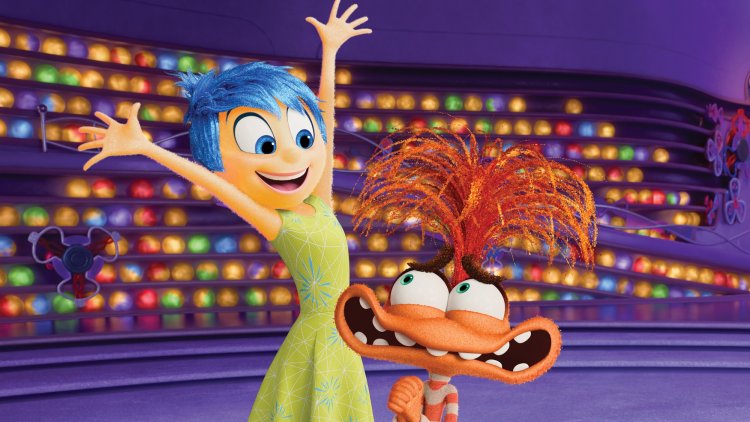When Anxiety Is Not a Superpower
Pixar’s Inside Out 2 has more emotions, and more blobs representing those emotions.

There is no feeling or metaphysical concept that Pixar Animation Studios can’t turn into some sort of blob. This was my complaint with the studio’s previous effort, 2023’s Elemental, which conjured a city populated by talking gobs of fire and water who clumsily embodied broader metaphorical topics. The first Inside Out, released nearly a decade ago, was the peak of Pixar’s blob cinema—a children’s drama about brightly colored beings representing human emotions such as joy and sadness, warring with one another as a representation of an 11-year-old’s evolving inner life. The systematization of something so multifaceted felt a little glib, but Pixar knows how to entertain, and so Inside Out pushed my buttons with practiced ease.
Inside Out 2 is, similarly, quite entertaining. Still, there were more than a few moments when I bristled at Pixar’s willingness to boil the headiest emotional concepts into the kind of bland CGI goop one might encounter during an Apple keynote. Joy being a chipper, canary-yellow lady, sure; Anger being a grumpy red stump with flames for hair, fine. But have you ever wondered what someone’s “sense of self” might look like? Inside Out 2 has the answer: a bunch of glowing strings tied into a tree-shaped bow. Every time staggeringly vague matters of the mind were reduced to screenwriting MacGuffins, some insidious blob in my own mind—call that emotion “David’s nonsense detector”—had me wondering what Jung might make of all this.
What spared me from rejecting Inside Out 2, however, is its appreciably low-stakes narrative. The film checks back in with the original protagonist, Riley, now 13 and navigating friendship drama as well as an upcoming switch to a new school. Set over a long weekend, the plot revolves around Riley seeking to fit in with older kids at hockey camp—like the first Inside Out, there’s a lot of hockey action. Given that Riley seems like a levelheaded kid, it’s pretty obvious that no major calamity is heading her way. But that’s not the vibe in her brain, where a red alarm labeled PUBERTY is flashing, and the broad emotions of the first film are being joined by more complex, often irritating beings.
Joining the original contingent of Joy (voiced by Amy Poehler), Sadness (Phyllis Smith), Anger (Lewis Black), Fear (Tony Hale), and Disgust (Liza Lapira) are Anxiety (Maya Hawke), Envy (Ayo Edebiri), Embarrassment (Paul Walter Hauser), and Ennui (Adèle Exarchopoulos)—a swirling quartet of very teenage sentiments that present themselves as part of Riley’s growth. Embarrassment mostly lurks silently; Ennui lounges on a couch looking at her phone; the pint-size Envy just ogles everything Riley sees with delight. But Anxiety, an orange sprite who’s all eyes, teeth, and baggage (she has a lot of suitcases), quickly starts hogging the console that controls Riley’s behavior and makes panicked decisions to avoid every nightmarish future, no matter how preposterous.
[Read: How Pixar lost its way]
The original Inside Out was about being in touch with your darker emotions; the perpetually sunny Joy had to learn to work with Sadness, realizing that her presence was a necessary part of life. The sequel should feel more complicated; anxiety is a more irrational emotion than the sweeping concept of “sadness,” and the notion of a mad actor suddenly governing one’s feelings does feel like the perfect analogy for teenhood. The problem is that this is still, at its heart, a movie for children, so a more typical quest-y story structure has to be imposed. After Anxiety evicts the original emotions to the back of Riley’s mind, Joy must search for Riley’s original, purer sense of self, which is being replaced by a more anxious variant represented by jagged orange lightning bolts.
The video-game logic of all this will always be a little facile. Which emotion controls the console? Which “sense of self” is plugged into it? Whose emotional superpower is mightiest? But the storytellers are at least wise enough to keep the narrative grounded by cutting up the drama of the mind—where most of the movie is set—with ongoing flashes of the real world. Yes, Riley’s good-natured sense of self might be lost deep in her mind caves, but on the surface, this means she’s being a little too unkind to her friends, a little too competitive on the rink, a little too eager to impress a hard-nosed coach and a cool older player. To her, every social misstep is a nightmare that fuels Anxiety’s power; to the viewer, it’s clear that this is basically all in her head.
I got enough laughs out of the new emotions—the chirpy Edebiri and the scathingly rude Exarchopoulos are highlights—to essentially enjoy Inside Out 2. But although it’s often charming and relatable, it’s a letdown when you consider the heights such a project could reach. This is a film set in the mind, and though it’s perhaps an unfair yardstick, my thinking immediately went to a movie for slightly older audiences, Hayao Miyazaki’s The Boy and the Heron—a work of dream logic and shifting psyches that overloads the audience with all kinds of dreamy, challenging imagery and lets them sift through it. Inside Out 2 is sweet, but all it has is blobs.
What's Your Reaction?




















